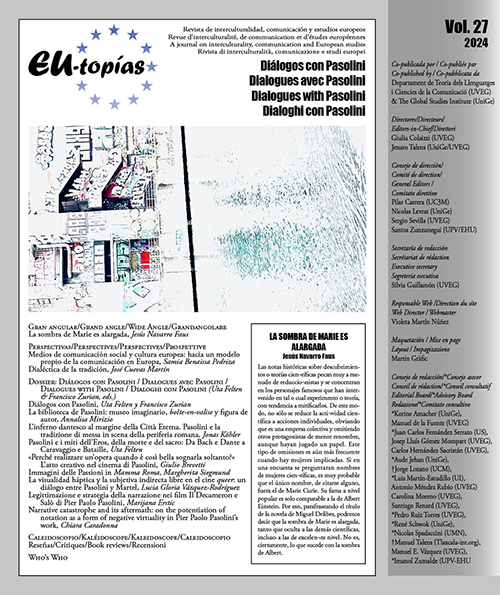«Why make a work when it is so beautiful to only dream of it?». The creative act in Pasolini’s cinema
DOI:
https://doi.org/10.7203/eutopias.27.28677Keywords:
Artist, director, painter, writer, creative process. Abstract
Abstract
Pupil of Roberto Longhi, the most influential historical and Italian art critic of the twentieth century, Pier Paolo Pasolini kept in mind the lesson of that teacher in the construction of his images, sometimes inspired by Renaissance and Mannerist paintings. But in addition to these well -known iconographic references in his movies, reflections on creative act and art in general are often found. The essay therefore aims to focus on some of these moments and to comment on specifically the figures of the artists who appear in some of his films, such as Giotto’s pupil by the same director played in the Decameron or as the director played by Orson Welles in La Ricotta. Through a reading of these examples, it will try to offer an interpretation of the author’s gaze on art and on the humans’ need to create and produce artistic artifacts.
 Downloads
Downloads
 References
References
Bazzocchi, Marco Antonio e Roberto Chiesi, a cura di. Folgorazioni figurative. Bologna: Cineteca di Bologna, 2022.
Bertolucci, Bernardo e Jean-Louis Comolli. “Le cinéma selon Pasolini”. Cahiers du cinéma, 169, 1965, poi in Pasolini, Pier Paolo. Le regole di un’illusione. I film, il cinema. Eds. Laura Betti e Michele Gulinucci. Roma: Associazione Fondo Pier Paolo Pasolini, 1991, p. 56.
Brevetti, Giulio. “Folgorazioni pasoliniane. Longhi, la pittura e il cinema nella mostra bolognese e nel catalogo dedicati al poeta e regista a cento anni dalla nascita”. Polygraphia, 6, 2022, pp. 333-346.
Pasolini, Pier Paolo. “Le pause di Mamma Roma” (diario al registratore, 2 e 4 maggio 1962). Mamma Roma. Milano: Rizzoli, 1962, poi in Pasolini, Pier Paolo. Le regole di un’illusione. I film, il cinema. Eds. Laura Betti e Michele Gulinucci. Roma: Associazione Fondo Pier Paolo Pasolini, 1991, p. 56.
Pasolini, Pier Paolo. “Una discussione del ’64”. Pier Paolo Pasolini nel dibattito culturale contemporaneo. Pavia-Alessandria: Amm.ne Provinciale di Pavia e Comune di Alessandria, 1977, pp. 119-120, 100, poi in Pasolini, Pier Paolo. Le regole di un’illusione. I film, il cinema. Eds. Laura Betti e Michele Gulinucci. Roma: Associazione Fondo Pier Paolo Pasolini, 1991, pp. 55-56.
Pasolini, Pier Paolo. Teorema. Milano: Garzanti, 1968, risvolto di copertina, poi in Pasolini, Pier Paolo. Le regole di un’illusione. I film, il cinema. Eds. Laura Betti e Michele Gulinucci. Roma: Associazione Fondo Pier Paolo Pasolini, 1991, p. 180.
Pasolini, Pier Paolo. “Io e Boccaccio”, intervista di D. Bellezza. L’Espresso colore. Roma-Milano, 47, 24 novembre 1970, poi in Pasolini, Pier Paolo. Le regole di un’illusione. I film, il cinema. Eds. Laura Betti e Michele Gulinucci. Roma: Associazione Fondo Pier Paolo Pasolini, 1991, p. 251.
Pasolini, Pier Paolo. “Stavolta tocca al Boccaccio inglese”, intervista di G. Grassi. La Domenica del Corriere, Milano, 5, 1 febbraio 1972, poi in Pasolini, Pier Paolo. Le regole di un’illusione. I film, il cinema. Eds. Laura Betti e Michele Gulinucci. Roma: Associazione Fondo Pier Paolo Pasolini, 1991, pp. 269-270.
Pasolini, Pier Paolo. Le regole di un’illusione. I film, il cinema. Eds. Laura Betti e Michele Gulinucci. Roma: Associazione Fondo Pier Paolo Pasolini, 1991.
Downloads
Published
How to Cite
-
Abstract99
-
PDF 17
Issue
Section
License
![]()
The authors conserve the copyright. All content published in EU-topías. Journal of interculturality, Communication, and European Studies are subject to the license Creative Commons Attribution-NonCommercial-ShareAlike 4.0 license. The full text of the license can be found at <http://creativecommons.org/licenses/by-nc-sa/4.0>
They may be copied, used, disseminated, transmitted and publicly displayed, provided that:
- The authorship and original source of the publication is cited (journal, publisher and URL of the work).
- They are not used for commercial purposes.
- The existence and specifications of this license of use are mentioned.
It is the responsibility of the authors to obtain the necessary permissions for images that are subject to copyright.



